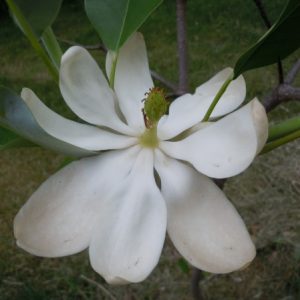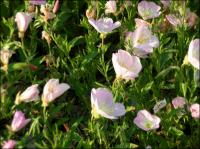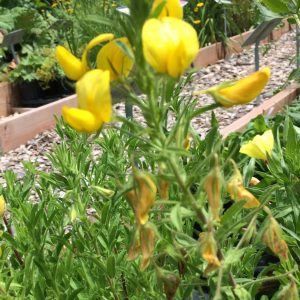Archives
Showing 105–112 of 164 results
-
Magnolia virginiana Sweetbay magnolia 5-10
Large, ivory cups, lemon scented
ARCHIVED
Note: This is a plant not currently for sale. This is an archive page preserved for informational use.
Large, ivory cups, lemon scented, in May & June & sporadically all summer & fall. 6” long leaves, waxy green on top and silvery-frosted beneath. In fall fruits open to reveal bright red seeds.
Size: 20’ x 15’
Care: Sun to part shade in acidic, moist to moist well-drained soil
Native: Atlantic coast from NY to FL, west along Gulf coast to TX
Wildlife Value: nectar source for Spicebush swallowtail butterflyMagnolia named for Pierre Magnol, Montpellier professor of medicine and director of the botanic garden. (1638-1715) This species collected by Rev. John Banister in Virginia c. 1690. One of the mainstays of John Bartram’s seed business, Peter Collinson, Bartram’s agent in England, said, “the name Magnolia will sell a box of seeds.” Offered for sale in Bartram Garden’s 1783 Broadside, America’s 1st plant catalog. Pressed specimen in Emily Dickinson’s herbarium.
-
Marshallia caespitosa Barbara’s Buttons Z 5-8
Dainty balls of white, fragrant flowers are borne on slender, leafless stalks, April to June
ARCHIVED
Note: This is a plant not currently for sale. This is an archive page preserved for informational use.
Dainty balls of white, fragrant flowers are borne on slender, leafless stalks, April to June
Size: 12-18” x 6-12”
Care: full sun to part shade in moist, well-drained soil
Native: KS to AR, LA & TX
Wildlife Value: Attracts bees and butterfliesMarshallia grows wild in prairies with Little bluestem and Coreopsis lanceolata. Nuttall, 1836
Genus name honors Humphry Marshall (1722-1801) and his nephew Moses Marshall (1758-1813), American botanists. -
Minuartia larcifolia Larch leaf sandwort Z 5-8
White blooms May-June over needle-shaped foliage
ARCHIVED
Note: This is a plant not currently for sale. This is an archive page preserved for informational use.
White blooms May-June over needle-shaped foliage
Size: 4-5” x 12-15”
Care: sun to part shade in moist well-drained to well-drained soil
Native: Mountains from Austria to SpainCollected before 1753.
-
Monarda bradburyana Eastern beebalm, Bradbury’s Monarda Z. 5-8
Whorls of pale pink hood-shaped petals with dark purple spots, April to June.
ARCHIVED
Note: This is a plant not currently for sale. This is an archive page preserved for informational use.
Whorls of pale pink hood-shaped petals with dark purple spots, April to June.
Size: 18-24" x 24"
Care: sun to part shade in moist well-drained to well-drained soil. Walnut toxicity resistant.
Native: IL west to KS, south from AL to TX
Wildlife Value: attracts butterflies and hummingbirdsNamed for its collector, Englishman Bradbury who searched for plants in central No. America in 1810. In gardens by 1826.
-
Myosotis palustris syn. M. scorpioides Forget-me-not Z. 5-9
Small gentian flowers with golden eyes, spring into fall
ARCHIVED
Note: This is a plant not currently for sale. This is an archive page preserved for informational use.
Small gentian flowers with golden eyes, spring into fall.
Can not ship to: New Hampshire
Size: 9-12” x 12”
Care: sun to part shade in moist soil
Native: temperate areas world wide“Myosotis” is Greek meaning mouse ear for the leaf shape. Around 1390 Henry IV adopted soveigne vous de moy, Forget-me-not, as a symbol not to forget his reign. A German legend attributes the common name to a lover who, gathering the flower, cried out “forget-me-not” as he fell into the river and died. Alfred Lord Tennyson wrote: “The sweet forget-me-nots; That grow for happy lovers.” Persian poet Shiraz told another folk tale: an angel fell from heaven by falling in love with a “daughter of earth,”when they sat by a river twining Forget-me-not flowers in her hair. The angel was not allowed to return until the lovers planted Forget-me-nots in every corner of the earth, which they did, hand in hand. She then became immortal “without tasting the bitterness of death” and joined the angel in Paradise.
-
Oenothera speciosa Evening primrose Z 5-8
June to August pale pink saucer-like blossoms
ARCHIVED
Note: This is a plant not currently for sale. This is an archive page preserved for informational use.
June to August ballerina pink saucer-like blossoms, excellent groundcover.
Size: 12" x 12" spreader
Care: Full sun moist well-drained to well-drained soil
Native: Southwest U.S. to MexicoAnother Thomas Nuttall discovery – 1819.
-
Ononis natrix Yellow restharrow Z 4-8
Yellow pea like flowers with red veins June- August
ARCHIVED
Note: This is a plant not currently for sale. This is an archive page preserved for informational use.
Yellow pea like flowers with red veins June- August
Size: 12” X 12”
Care: sun in dry soil
Native: Syria, Lebanon, Palestine, Jordan, Egypt, Tunisia, Algeria, Morocco, Circum-MediterraneanLinnaeus 1753
-
Papaver orientale ‘Beauty of Livermere’ Z 3-9
Glossy fire engine red petals with black heart in June.
ARCHIVED
Note: This is a plant not currently for sale. This is an archive page preserved for informational use.
Scarlet, tissue-thin petals surround a purple blotch at the base highlighted with purple stamens
Size: 3' x 2'
Care: sun in well-drained soil. Foliage dies back in summer & reemerges in the cool autumn.
Wildlife Value: Attracts hummingbirds, bees & butterflies. Deer & rabbit resistant.This red selection listed in Matineau’s book 1910






